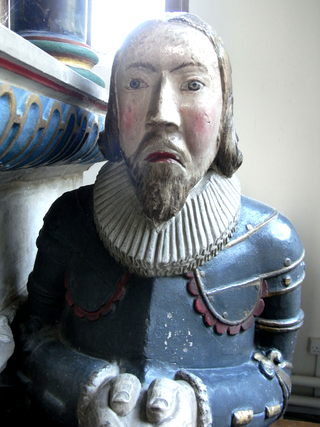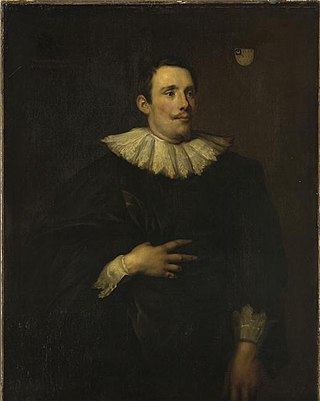Related Research Articles

Duke of Somerset, from the county of Somerset, is a title that has been created five times in the peerage of England. It is particularly associated with two families: the Beauforts, who held the title from the creation of 1448, and the Seymours, from the creation of 1547, in whose name the title is still held. The present dukedom is unique, in that the first holder of the title created it for himself in his capacity of Lord Protector of the Kingdom of England, using a power granted in the will of his nephew King Edward VI.

William Seymour, 2nd Duke of Somerset, was an English nobleman and Royalist commander in the English Civil War.

Alexander Popham of Littlecote, Wiltshire, was an English politician who sat in the House of Commons at various times between 1640 and 1669. He was patron of the philosopher John Locke.

Rodney Stoke is a small village and civil parish, located at grid reference ST486501, 5 miles north-west of Wells, in the English county of Somerset. The village is on the A371 between Draycott and Westbury-sub-Mendip.

Francis Seymour, 1st Baron Seymour of Trowbridge, of Marlborough Castle and Savernake Park in Wiltshire, was an English politician who sat in the House of Commons at various times between 1621 and 1641 when he was raised to the peerage as Baron Seymour of Trowbridge. He supported the Royalist cause during the English Civil War.

Frances Seymour, Duchess of Somerset was an English noblewoman who lived during the reigns of Elizabeth I, James I, Charles I and Charles II. Her father was Robert Devereux, 2nd Earl of Essex, Elizabeth I's favourite who was executed for treason in 1601. She was the second wife of William Seymour, 2nd Duke of Somerset, and the mother of his seven children.

Sir Francis Popham (1573–1644) of Wellington, Somerset, was an English soldier and landowner who was elected a Member of Parliament nine times, namely for Somerset (1597), Wiltshire (1604), Marlborough (1614), Great Bedwin (1621), Chippenham 1624, 1625, 1626, 1628–29), and for Minehead (1640–1644).

Greville Verney, 7th Baron Willoughby de Broke and de jure 15th Baron Latimer of Compton Verney in Warwickshire, England, served twice as a Member of Parliament for Warwick, in 1614 and 1621.

Sir Edward Hungerford (1596–1648) of Corsham, Wiltshire and of Farleigh Castle in Wiltshire, Member of Parliament, was a Parliamentarian commander during the English Civil War. He occupied and plundered Salisbury in 1643, and took Wardour and Farleigh castles.
Sir Miles Sandys, 1st Baronet was an English landowner and politician who sat in the House of Commons at various times between 1614 and 1629.
Sir Neville Poole was an English politician who sat in the House of Commons variously between 1614 and 1648. He supported the Parliamentarian side in the English Civil War.

Sir John Strangways of Melbury House, Melbury Sampford, Somerset, and of Abbotsbury in Dorset, was an English politician who sat in the House of Commons variously between 1614 and 1666. He supported the Royalist side in the English Civil War.
Sir William Uvedale was an English politician who sat in the House of Commons at various times between 1614 and 1645. He supported the Royalist cause in the Civil War.

Sir Gilbert Hoghton, 2nd Baronet was an English politician who sat in the House of Commons variously between 1614 and 1640. He was a Royalist leader during the English Civil War.

Sir William Strode (1562–1637) of Newnham in the parish of Plympton St Mary, Devon, England, was a member of the Devon landed gentry, a military engineer and seven times a Member of Parliament elected for Devon in 1597 and 1624, for Plympton Erle in 1601, 1604, 1621 and 1625, and for Plymouth in 1614. He was High Sheriff of Devon from 1593 to 1594 and was knighted in 1598. In 1599 he was appointed Deputy Lieutenant of Devon. There is a monument to him in the parish church of Plympton St Mary.
Sir Edward Peyton, 2nd Baronet was an English landowner and politician who sat in the House of Commons at various times between 1621 and 1629. He fought for the Parliamentary cause in the English Civil War.
Sir Henry Seymour was an English landowner and MP, the brother of Jane Seymour, queen consort of Henry VIII, and consequently uncle to Edward VI. He was created a Knight of the Bath after his nephew's coronation.
Sir Robert Southwell (1563–1598), of Woodrising, Norfolk, was an English politician.

Sir John Strode, of the Middle Temple, London and Chantmarle, Cattistock, Dorset, was an English MP for Bridport in 1621 and 1625.

Frances Southwell was an English courtier.
References
- ↑ Johanna Luthman, Family and Feuding at the Court of James I: The Lake and Cecil Scandals (Oxford, 2023), p. 234.
- 1 2 Godfrey Basil Mundy The life and correspondence of the late Admiral Lord Rodney
- ↑ Knights of England
- ↑ Willis, Browne (1750). Notitia Parliamentaria, Part II: A Series or Lists of the Representatives in the several Parliaments held from the Reformation 1541, to the Restoration 1660 ... London. pp. 229–239.
- ↑ Rodney's Trained Band Regiment at the British Civil Wars Project.
- ↑ Johanna Luthman, Family and Feuding at the Court of James I: The Lake and Cecil Scandals (Oxford, 2023), p. 234.
- ↑ Broadway, Jan (2006). No historie so meete. Manchester University Press. p. 50.
- ↑ Wall monument to Sir Edward and Lady Frances Rodney